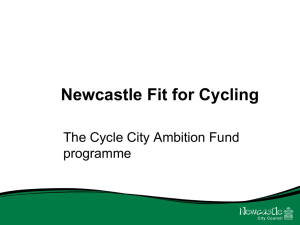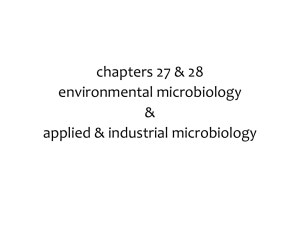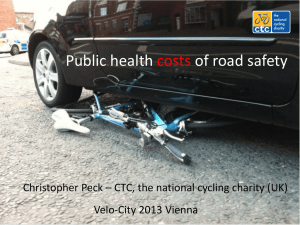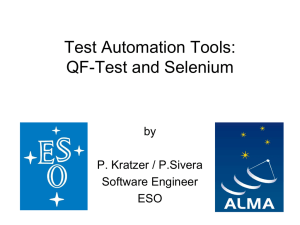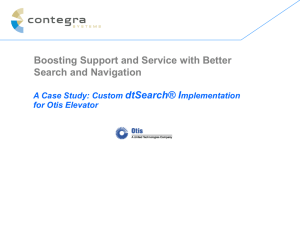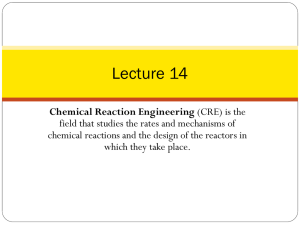Bailey_GSA_2013
advertisement
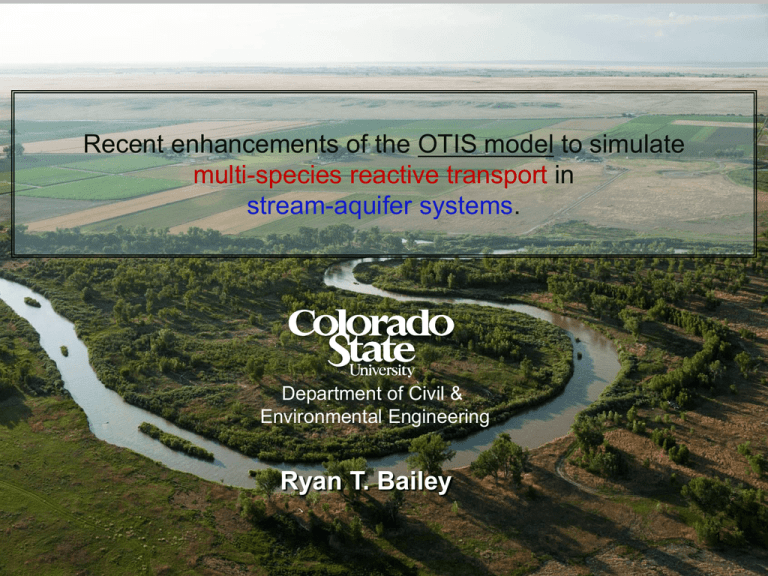
Recent enhancements of the OTIS model to simulate multi-species reactive transport in stream-aquifer systems. Department of Civil & Environmental Engineering Ryan T. Bailey 1 Overview of Presentation OTIS Arkansas River Basin, CO Fertilizer Shale Fate and transport of Nitrogen, Selenium species (remediation) in river network. Modifications to OTIS code Background & Motivation • Need tool to simulate in-stream solute concentration in groundwater-driven watersheds • Assess influence of remediation strategies (BMPs) on in-stream concentration of NO3 and Se species Irrigated Fields Groundwater flow model (MODFLOW-UZF1) Reactive transport model (UZF-RT3D) Groundwater solute concentration (NO3, Se) Solute mass loadings to Arkansas River What about in-stream solute concentration? All river segments impaired for Selenium (4.6 µg L-1 for Aquatic Life) Selenium Nitrate Project Objectives Identify effective regional-scale remediation strategies to decrease in-stream concentrations of Selenium and Nitrate I. Develop model for Se and N transport in Streams (OTIS) 1. Network of Connected Streams 2. Interaction between Chemical Species 3. Nitrogen Cycling Processes 4. Selenium Cycling and Transformation 5. Apply model to Arkansas River Basin (Testing, Sensitivity Analysis) II. Couple model with UZF-RT3D (groundwater-surface water) III. Explore remediation strategies I. Develop model for Se and N transport in Streams Model Requirements - Handle Steady and Unsteady Flow - Inputs/Outputs (mass loading from aquifer) - Multiple solutes - Apply to Stream Networks - Chemical reactions / transformations (interacting species) - Nitrogen cycling, Selenium cycling and transformation Modifications Model Development - Base Model: OTIS (One-Dimensional Transport with Inflow & Storage) (Runkel, 1998) I. Develop model for Se and N transport in Streams Model Requirements - Handle Steady and Unsteady Flow - Inputs/Outputs (mass loading from aquifer) - Multiple solutes - Apply to Stream Networks - Chemical reactions / transformations (interacting species) - Nitrogen cycling, Selenium cycling and transformation Stream Network Mass balance Input Files: Parameters for each stream I. Develop model for Se and N transport in Streams Model Requirements - Handle Steady and Unsteady Flow - Inputs/Outputs (mass loading from aquifer) - Multiple solutes - Apply to Stream Networks - Chemical reactions / transformations (interacting species) - Nitrogen cycling, Selenium cycling and transformation Concentration of Solute 1 Affects concentration of Solute 2 dC 1 dt k 1C 1 dC 2 dt k 1C 1 k 2 C 2 System of differential equations Solve using 4th-order Runge-Kutta method I. Develop model for Se and N transport in Streams Model Requirements - Handle Steady and Unsteady Flow - Inputs/Outputs (mass loading from aquifer) - Multiple solutes - Apply to Stream Networks - Chemical reactions / transformations (interacting species) - Nitrogen cycling, Selenium cycling and transformation QUAL2E Nitrification ofOTIS Input File NH4, NO2 Decompose organics Oxygen O2 Sediment demand Algal Photosynthesis Respiration Atmospheric Reaeration Groundwater Algae Biomass to N Uptake Uptake Organic N Settling Min. NH4 Diffusion from Sediments Nitrif. NO2 Nitrif. Groundwater NO3 Denitrification I. Develop model for Se and N transport in Streams Model Requirements - Handle Steady and Unsteady Flow - Inputs/Outputs (mass loading from aquifer) - Multiple solutes - Apply to Stream Networks - Chemical reactions / transformations (interacting species) - Nitrogen cycling, Selenium cycling and transformation + Algae/ Aquatic Plants Respiration Uptake Org Se Min. SeO4 Sorption Red. SeMet Settling Volatiliz. Volatil. Uptake SeO3 Red. Se Red. Groundwater Se2- I. Develop model for Se and N transport in Streams Apply model to Arkansas River Basin Sensitivity Analysis Assess influence of parameters on NO3 and O2 OTIS grid 34 flow and transport parameters Steady flow in Arkansas River 6 Tributaries 2006-2008 simulation period Processing SA Results: - Sensitivity indices - Temporal values of indices - Spatial values of indices I. Develop model for Se and N transport in Streams Apply model to Arkansas River Basin Transient Flows Flow rates: MODFLOW-SFR Transient upstream BC for O2, NO3, and SeO4 Field work: sample Se in water, sediments, stream bank Compare against in-stream O2, NO3, and SeO4 2006-2010 (12 sampling events) Sampling sites II. Couple Model with UZF-RT3D Groundwater-Surface Water Coupling SFR2 Package MODFLOW-UZF FLOW Groundwater discharge Groundwater Flow Stream Seepage Linker file REACTIVE TRANSPORT CD Groundwater Solute Transport Solute mass loading Solute mass depletion UZF-RT3D CS Surface Water Flow Output (Q, depth, lateral inflow,…) Surface Water Solute Transport OTIS* Imbedded within RT3D Discharge CD Seepage CS II. Couple Model with UZF-RT3D Groundwater-Surface Water Coupling Groundwater flow model (Eric Morway, USGS) (MODFLOW-UZF1) Reactive transport model (N, Se cycling packages) (UZF-RT3D) Stream Network Flow Model: SFR2 package for River, Tributaries Divided into stream segments Transport Model: QUAL2E parameter values Sampling Sites Testing Data: Stream flow, stream depth In-stream conc. of O2, NO3, SeO4 II. Couple Model with UZF-RT3D Groundwater-Surface Water Coupling Rocky Ford gage La Junta gage Preliminary RT3D-OTIS simulations Next Phases - Further Calibration/Testing of RT3D-OTIS model - Explore Effect of Remediation Strategies Reduce irrigation Reduce canal seepage Reduce Nitrogen fertilizer loading Implement/Enhance Riparian buffer zones

